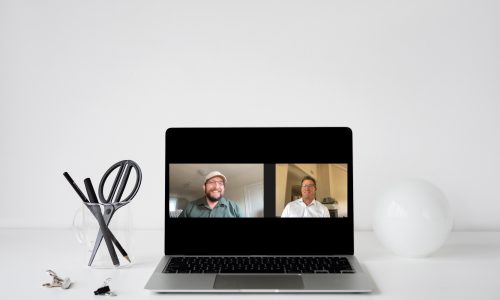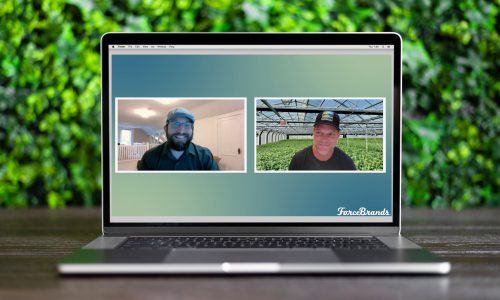Launched in 2010 in Boulder, Colorado, Keef Brands is a leader in the cannabis beverage space. And while beverage makes up only a small percentage of the market, it has the potential to be one of the most disruptive categories.
We caught up with the company’s President and Chief Executive Officer Travis Tharp who just celebrated his five-year anniversary at Keef Brands. In this episode of Cannabis Matters, Tharp takes us behind the scenes of how he approaches hiring, industry challenges, and more.
Watch his interview with ForceBrands’ Client Strategist and series host Eric Rosen and read the transcription of the conversation below:
Eric Rosen: Travis, welcome to Cannabis Matters. Thank you so much for joining us today.
Travis Tharp: Of course. Thanks for having me, Eric. Appreciate it.
ER: How long have you been in the cannabis space? Tell us a little bit about what drew you here and what the attraction to the cannabis space was.
TT: I joined in 2017. I just celebrated my five-year anniversary both at Keef and in cannabis. They have been very intertwined. I came from outside of the industry and I was very fortunate I grew up in Boulder, Colorado and one of my good friends growing up was the founder of Keef. In 2010, right when I was coming out of business school, he said he was going to put cannabis in a soda and I thought he was crazy. I was just going to go do a VR-type startup. Turns out, I was the crazy one and he was on to something. I had been living in Los Angeles for about a decade and had wanted to come back to Colorado and this seemed like the right time to make the jump. It was a little before cannabis was starting to really take off and I really believed in the vision that Erik had for the company and where this category could go for using beverage as a functional delivery mechanism for cannabis. It’s been a wild ride ever since.
ER: Along the lines of, ‘I wish I would have known then what I know now,’ what advice would you give folks that are just getting started out, both from a pain point and things to avoid standpoint and also from an opportunity perspective?
TT: Don’t underestimate the level of challenges that you’re about to undertake.
I was naive when I came into the industry thinking that you could take certain business practices that work in other industries and immediately apply them to cannabis.
I always liked applying technology into the space and I was hit over the head with a lot of restrictions and things that we could do out of the gate and it’s been a challenge trying to merge previous life with current life and making sure that we can guide it and be data-driven and do all the things that we know we eventually need to do to become a strong recognizable CPG-type brand five to ten years down the road.
ER: On the data-driven front, how are you currently leveraging data from embracing data-driven strategies using what the marketplace is doing at scale but in a measurable fashion to kind of drive your next move both strategically and tactically?
TT: That was one of the learnings when I first came into this. It was largely intuition-driven. There wasn’t a lot of data capture. The industry wasn’t set up for that yet and it’s done a really good job of catching. Some of the things that Keef has been working on the last few years is doing controlled tests, understanding what we can do in certain markets. We’re fortunate to be headquartered in one of the original markets and we can run some tests in Colorado where there has been some retail consolidation a couple years prior to some of the other markets that are starting to experience this. We’ve gotten to test some things and understand what works from an acquisition funnel side, what works from the conversion side, and are we able to actually have these measurable approaches while also not losing sight of the core revenue driver which is the retail model that is still driving the vast majority of sales throughout this. So it’s a balancing act.
ER: On the note of retail, since you’ve joined the industry, what inflection points, what paradigm shifts have you seen happen at the macro level at the industry level?
TT: Yeah I think the one that jumps up, and I don’t think this will be an earth-shattering revelation, but it was when Covid came, everybody from the retailers to the brands to the cultivators, everybody needed to take a firm look inward and understand how they were running their business. As part of beverage, we’re still a relatively small portion of the overall cannabis industry. We’re still in the 1 to 2 percent right now. We expect it to grow very quickly.
ER: How has the art and science of building and attracting and forming teams changed for you since Covid started. As you mentioned you know everyone’s in need of introspecting at the individual as well as the organizational level. I’m curious how that impacted the way you think about building teams.
TT: I think there have been some positives that have come from this, especially in the cannabis sector of needing to acknowledge that the benefits and putting the needs of the employees front and center as a tool to hire and retain top talent — especially talent that’s starting to get comfortable with the jump from mainstream CPG and other type industries over into cannabis — is really making sure that you have your ducks in a row, and I think that is something that we really focused on over the last couple years. We’ve worked with ForceBrands in the past and gotten some great folks.
ER: I love what you said about benefits, having the entire employee package having to evolve to kind of meet the needs of the kind of candidates that you want to bring into the organization based on the velocity and trajectory of success you’re at today. Along with that, I think you’d agree a common theme amidst cannabis companies that have either been part of the legacy market and have now come into the legal market or just started within the legal market, there’s always a balance of right-sizing talent from we’ll call it the traditional market, the old school, the legacy players that really have a finger on the pulse, a deep nuanced sense of what the space is, and then you also have this almost contrasting need for outside talent who can help level you up to national distribution when we get there and everything that goes along with that. So I’m curious, how do you think about balancing the need for the right mix of legacy talent as well as new talent?
TT: I think I’d say this for anyone who comes from outside the industry, you don’t know as much as you think you do and you probably need to listen to some of these legacy operators, even though some of the things that you hear initially seem counter-intuitive to how you would approach a certain situation. I think you learn over time that there’s a distinct benefit in understanding how the early players of the industry have come about and how they used to operate, how they’ve evolved operating.
In any interview that I give, I always try to give a shout-out to the folks who came in and started this industry over 10 years ago because the number of risks that they undertook to do this — I mean compared to what I even dealt with five years ago — it was night and day.
I think the biggest thing that we look for is somebody who’s malleable enough to understand both sides because there are a lot of folks who understand one but cannot speak or interact with the other and that’s just a non-starter. We are always looking for folks that understand some of the uniqueness of the industry, and have some exposure but I think finding folks that are that have worked in the trajectory of growth, like growth in craft beer, that’s something that we look at because they underwent a similar trajectory that we’re about to undergo right now.
ER: Craft beer is actually a fantastic metaphor for looking for people to understand the nuances of a sub-industry and also you know have the need and desire to scale to a national level. One thing I respect deeply about Keef Brands is your original commitment to the medical side of the space has stayed constant yet you’ve also evolved into the recreational side for all sorts of folks that are canna-curious and the like with microdoses and I’m curious how you think about that from a product formulation because you’re not just building products for today you’re also building — R&D is about the next 18 months, 24 months, three years, five years, so I’m curious how that evolution of thinking has evolved over the course of your time at Keef Brands.
TT: We recognize that the medical consumer, the medical patient is the reason that we’re standing here today. I think there’s a lot of focus right now on the low-dose introductory edible segment, which I think is great for mainstream acceptance and we definitely look at that and we think that’s great for building the category but we also understand that part of the reason why we had success was because we addressed a need for people who were daily users and people who have a much higher tolerance than I could ever fathom to have. I’m not afraid to admit it. Those are the folks that join the industry early, those were the hand-raisers, those were the folks that were on the front lines in the dispensary trying to help be the guide to people that are coming here and we’ve benefited from having a really tight and strong relationship with that segment which is no small segment. It’s a big, big segment so we always try to meet the market where it’s at in each individual state that we come to we have plans to always roll out the more mainstream mass-appeal products but we never want to lose sight of the original group that has gotten us to where we are today.
ER: One thing that you hear a lot about is the entourage effect or the symphonic effect and it’s typically in the flower segment. Sometimes it’ll be in the full-spectrum, extracts, and the live rosin or cold water hash side of things. You rarely hear about it in the beverage segment so I’m just delighted to hear the minor cannabinoids piece entering into the beverage segment. How is Keef Brands thinking about the concept of the entourage effect? Is it a thing for optics and for marketing, or is there science yet that’s supporting the entourage effect also existing with infused beverages?
TT: What we have to do is we have to look at it and say, here we are at point A in the journey of beverage as part of cannabis. We’re still under 2 percent. We need to educate more so around some of the benefits of beverage as a delivery mechanism versus some of the other edibles, such as a faster uptake because it doesn’t have to go through your digestive tract. You can have a more sessionable experience that is akin to what you do with alcohol. I think those are the building blocks there need to be put in place before you can start attacking. We are going to address this niche’s niche for this specific consumer because if we do that like we would be doing the overall industry a disservice. I think we need to start with the building blocks of education of why beverage is better than some of the other form factors so focusing in on that level of education why beverage can be a substitute and a really interesting substitute for not just other forms of cannabis but also for people trying to re-examine their relationship with alcohol.
ER: If we look outwards, if we look at the next year, three years, five years, do you think that beverages like 1-to-1 ratio beverages with more and more CBD in them will help to expand the 1 or 2 percent market penetration into the broader population?
TT: I do and what’s really interesting to see is in each successive market that we go into we start to see the adoption rate of beverage accelerate and then adoption rate of our brand is higher than the previous market before that. You can take Canada for example. The proportion of folks using beverage out of the gate is higher than it was in the U.S and that’s really good and there’s a broad swath of reasons for that and there’s a great selection and there are great different types of brands up north that are really driving that and I think that we have an opportunity to help guide and drive that here in the States.
ER: When you compare and contrast Canada versus the States, what are you seeing in terms of in terms of similarities but I would say more importantly, differences?
TT: I’m not really sure that I’m at a point where I can anoint which system is better and who’s doing it better at this point in time. I know that in every single state, different regulations are there and we always have to work within those constructs and it’s not like just growing one business and scaling it. It’s basically like growing 10 distinct businesses throughout all the different markets that we have because we have captive supply chain, captive marketing rules, different nuances of things that we do and we can’t take advantage of some of the supply chain advantages that a traditional industry could do. But I’m really encouraged with our early traction in Canada. I love that we’re able to have one facility that can supply the whole country. That allows us to scale a little bit more with our partners BevCanna but I also can appreciate the ability to be quick and move from one market to the next in the U.S. and I think being able to understand that and not just trying to shove a square peg into a round hole in the U.S. is something that’s allowed us to be successful in certain markets.
ER: And looking into the future, what’s your take on federal legalization? Is it going to happen? What is it going to look like? Is it going to be a rescheduling, descheduling, and what’s that going to look like for infused beverages?
TT: You could ask 20 different people and they’d probably give you 20 different answers. I always look back on post-prohibition alcohol. Interstate commerce didn’t happen overnight once that was restricted and I don’t think that will happen with cannabis. I think we’re going to see this rollout over the course of 10 to 15 years of an adjustment and an evolution into a national market versus just a patchwork of individual markets. I could not bet on when they’re actually going to do it. I would think that we would see something within the next two to four years, which is a huge swath of time, but I do see positive momentum on both sides of the aisles and I start to see the regulatory infrastructure of the local states just taking the lead on this and passing it so that we’ll get to a place where it’s almost a moot point to have federal legalization because so many of these other states and just localities have approved it. And I think that’s really what’s going to happen and it’ll get there and innovation always goes faster than regulation.
ER: What are you most excited about the cannabis space today and the cannabis space tomorrow? What is the single thing that gets you up in the morning just excited to jump out of bed?
TT: Every day is its own new challenge, and I think there’s a certain level of craziness to everybody who works in this industry, if not crazy at least a little bit of eccentricity, but what I love about it is that very few times in a career can you be on the ground floor building an entire industry that comes along only once in a generation. I spend most of my time in the weeds on tough things and I have to pull myself out and go okay wait a minute this is really cool. And then when you think about beverage as a sub-segment of it, it’s like three false starts of being anointed as the next big thing but in spite of it like it’s continuing to make incremental gains and if you look at what the most popular mainstream forms of consumption are, you know that there has to be a place for this so if we can stay true to our north star, be nimble, get out there, and really be in front of the pack to help educate folks, we’re going to have a place at the table down the road and any conversations about future funding or future consolidation of the industry like if we’re focused on doing this right, like those will all come about. What it’s really about is just making sure you have a consistent quality product that speaks to consumers and is easy to understand.
ER: Travis, thank you so much for spending time with us today.
TT: No, thank you guys, you know I love the crew of ForceBrands.
Catch up on more episodes from Cannabis Matters here.
Interested in learning more about the cannabis industry and how ForceBrands’ cannabis practice can help grow your business or career? Reach out to Eric Rosen to start the conversation.






